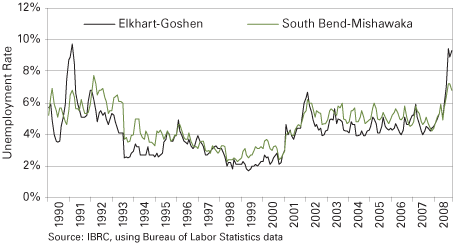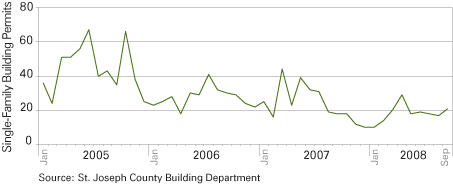South Bend and Elkhart Area Forecast 2009
Director, Bureau of Business and Economic Research; Assistant Professor of Economics, School of Business and Economics, Indiana University South Bend
November 2008
The Michiana region, comprised of the South Bend–Mishawaka (St. Joseph County) and Elkhart–Goshen (Elkhart County) areas, will rebound slowly in 2009 after facing a weakened economy in 2008. Recovery will depend on manufacturing conditions and the overall national economy.
Output
Real gross domestic product (GDP) for the region has increased.1 Real GDP grew 0.1 percent in 2005–2006 in South Bend and 3 percent in Elkhart. In 2004–2005, South Bend's real GDP declined 2.3 percent, while Elkhart's expanded 2.7 percent. The size of the local economies in 2006 was $10.1 billion (chained 2001 dollars) in South Bend and $9.5 billion in Elkhart.
Employment
The region has faced weakening labor markets overall. Figure 1 shows metropolitan unemployment rates from 1990 to 2008.2 Unemployment rates escalated rapidly in 2008, reaching their highest levels since the early 1990s. Due to substantial declines in employment in transportation equipment and related industries, Elkhart's unemployment rate surpassed South Bend's—reversing a long-time trend. Regional unemployment rates also grew worse relative to state and national averages.
Figure 1: Unemployment Rate, 1990 to 2008

Table 1 reports employment data by industry for the region's metropolitan areas. Approximately 268,100 people are employed in nonfarm sectors across the region, with employment being about 17,900 higher in South Bend compared to Elkhart. From September 2007 to September 2008, total nonfarm employment in South Bend and Elkhart decreased 3.2 percent with a loss of 3,500 jobs in South Bend and 5,300 jobs in Elkhart. That is substantially more than the approximately 0.1 percent decline the previous year—a condition then not seen since 2003 when employment fell from the year before.
Table 1: Employment in South Bend–Mishawaka, Elkhart–Goshen, and the Combined Area, September 2008
| Industry | South Bend–Mishawaka | Elkhart–Goshen | Combined | |||
| Employment | Change Since September 2007 | Employment | Change Since September 2007 | Employment | Change Since September 2007 | |
| Total Nonfarm | 143,000 | -3,500 | 125,100 | -5,300 | 268,100 | -8,800 |
| Manufacturing | 19,000 | -900 | 58,500 | -3,800 | 77,500 | -4,700 |
| Trade, Transportation, and Utilities | 27,800 | -700 | 17,900 | -700 | 45,700 | -1,400 |
| Educational and Health Services | 32,500 | -200 | 11,300 | 0 | 43,800 | -200 |
| Government | 16,600 | -600 | 8,900 | -100 | 25,500 | -700 |
| Professional and Business Services | 13,700 | -500 | 8,700 | -200 | 22,400 | -700 |
| Leisure and Hospitality | 12,200 | -300 | 7,400 | -300 | 19,600 | -600 |
| Natural Resources, Mining, and Construction | 6,600 | 0 | 4,500 | 0 | 11,100 | 0 |
| Financial Services | 6,900 | -100 | 3,100 | -100 | 10,000 | -200 |
| Other Services | 5,700 | 0 | 4,100 | 0 | 9,800 | 0 |
| Information | 2,000 | -200 | 700 | -100 | 2,700 | -300 |
Source: Bureau of Labor Statistics
Manufacturing employment fell by 4,700 jobs due to heavy layoffs and closings in transportation and related sectors. Heavily affected by plummeting RV production, Elkhart lost 3,800 manufacturing jobs. Manufacturing employment will likely remain uncertain in the year ahead as the RV and automotive markets remain sluggish and exports decline due to softening global demand.
Unlike the previous year, nonmanufacturing employment also saw sizeable employment losses from September 2007 to September 2008. No sectors experienced employment gains. Some sectors—including natural resources, mining, and construction and other services—remained stagnant, likely due to the sluggish national economy. The largest nonmanufacturing losses were in trade, transportation, and utilities, with a combined loss of 1,400 jobs in the region. Other sectors suffering sizeable losses included government, professional and business services, and leisure and hospitality. Losses in these sectors were particularly strong in South Bend. Educational and health services saw no change in Elkhart but declined by 200 jobs in South Bend. Employment in services and trades will likely remain poor as demand weakens due to continued low spending and unstable financial markets.
Wages
Over the past year, wages changed quite differently across the region.3 The average weekly wage rose 6 percent from the first quarter of 2007 to the first quarter of 2008 in South Bend but remained unchanged in Elkhart. Wages had grown 1.7 percent the previous year across the region. The increase in wages in South Bend coincides with more rapid inflationary pressures in late 2007 and early 2008, while the decline in Elkhart's average wage likely stems from lower labor demand in manufacturing sectors. Manufacturing wages fell 0.6 percent in Elkhart but rose 8 percent in South Bend. Average wages in retail fell 7.1 percent in South Bend but rose 4.1 percent in Elkhart. In health care and social services, wages rose 2.4 percent in Elkhart but only 0.1 percent in South Bend. Expected slower inflation in 2009 and continued weak labor demand in many sectors will contribute to slower growth in wages over the coming year.
Housing
Residential construction, measured by the number of new single-family housing permits issued in St. Joseph County, remained soft in 2008 (see Figure 2). From January 2008 to September 2008, 166 new housing permits were issued, compared to 247 during the same period in 2007, 256 in 2006, and 403 in 2005. Early 2008 reversed the decline experienced in much of 2007, but the turnaround was short lived, with a drop in new housing permits in mid-2008. A slight positive gain emerged in September 2008. The continuance of this development is uncertain as real estate markets stay sluggish and outcomes in financial markets remain unclear. Michiana will likely continue to face weak housing markets because of weak demand, growing inventories of existing homes, and tougher credit markets.
Figure 2: Single-Family Residential Building Permits in St. Joseph County, 2005 to 2008

Summary
In 2007 and 2008, the Michiana region experienced a sluggish economy: declining employment, accelerating unemployment rates, mixed changes in wages, and continued slow real estate markets. The outlook for 2009 is far from optimistic and faces considerable uncertainty. Much of what was seen in the past year will likely continue, with hope for some recovery as the nation's economy gradually recovers and financial markets stabilize. Deterrents, such as weakening global demand, ongoing cautious spending, and fragile transportation-related manufacturing, will hamper the growth that does occur.
Notes
- GDP data for the South Bend–Mishawaka metro include Cass County, Michigan. GDP data are from the Bureau of Economic Analysis, 2008, www.bea.gov/newsreleases/regional/gdp_metro/gdp_metro_newsrelease.htm.
- STATS Indiana, Labor Force Estimates Timeseries View, 2008, www.stats.indiana.edu/laus/laus_view3.html.
- STATS Indiana, Quarterly Census of Employment and Wages, 2008, www.stats.indiana.edu/cew/.
Also in this Issue…
- Outlook for 2009
- International Outlook for 2009
- U.S. Outlook for 2009
- Financial Outlook for 2009
- Housing Market Outlook for 2009
- Indiana's Outlook for 2009
- Indiana's Agricultural Outlook for 2009
- Indiana's Special Sectors Outlook for 2009
- Anderson Forecast 2009
- Bloomington Forecast 2009
- Columbus Forecast 2009
- Evansville Forecast 2009
- Fort Wayne Forecast 2009
- Gary Forecast 2009
- Indianapolis-Carmel Forecast 2009
- Kokomo Forecast 2009
- Louisville Forecast 2009
- Muncie Forecast 2009
- Richmond Forecast 2009
- South Bend and Elkhart Area Forecast 2009
- Terre Haute Forecast 2009
- Return to Table of Contents



